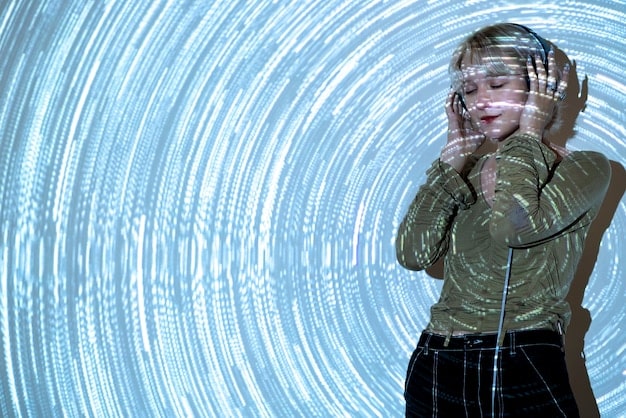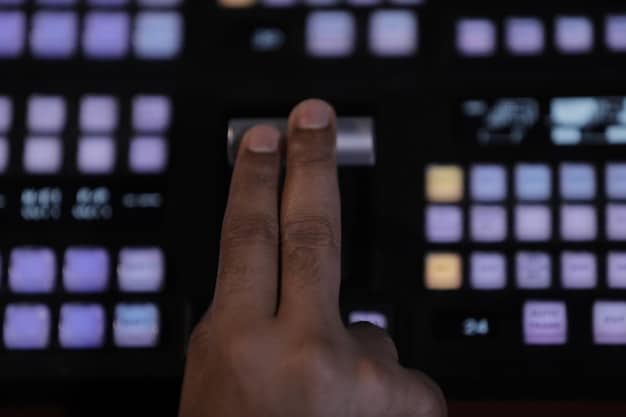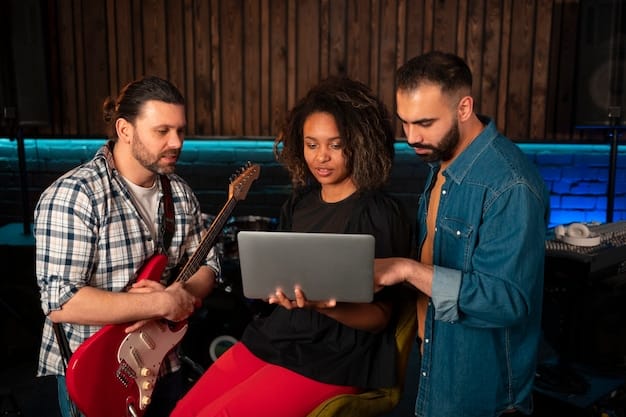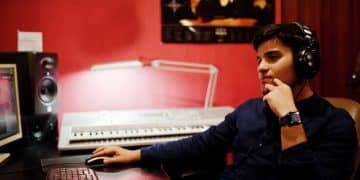The Art of the Beat: AI’s Role in Hip Hop Production

AI is revolutionizing hip hop production by offering producers innovative tools for sound design, beat creation, and artistic exploration, fundamentally reshaping the genre’s sonic landscape and pushing creative boundaries.
The beat is the heartbeat of hip hop, a pulsating foundation that drives the narrative and energy of every track. For decades, producers have sculpted these intricate rhythms, blending samples, instruments, and synthesis to forge iconic sounds. But what if the very essence of beatmaking, The Art of the Beat: How Producers Are Using AI to Create the Next Generation of Hip Hop Sounds, is undergoing a profound transformation? Artificial intelligence, once a distant concept for creative fields, is rapidly becoming an indispensable tool in the producer’s arsenal, ushering in an unprecedented era of sonic innovation for hip hop.
the evolution of hip hop production: from analog to algorithm
Hip hop’s sound signature has always been a product of evolving technology. From the raw power of drum machines like the Roland TR-808 and the gritty textures of sampled vinyl to the digital precision of DAWs (Digital Audio Workstations), each technological leap has redefined what was possible. This continuous innovation has fostered a culture of experimentation, where producers constantly push boundaries, seeking novel ways to craft their auditory narratives.
The early days were defined by hardware. Turntables, mixers, and dedicated drum machines were the mainstays, dictating a particular workflow and sonic aesthetic. Producers meticulously chopped samples, arranged patterns, and applied effects, often working within the limitations of their gear. The advent of digital samplers and eventually DAWs democratized production, opening doors for a new wave of bedroom producers and studio maestros alike, offering unprecedented control and flexibility.
sampling’s digital transformation
Sampling, a cornerstone of hip hop, moved from physical manipulation of records to intricate digital processing. Software samplers allowed for more precise cuts, time-stretching, and pitching, offering a broader palette of sounds. This digital shift, while extending creative possibilities, also paved the way for computational approaches to sound manipulation.
- Expanded sonic diversity through advanced digital sample editing.
- Greater control over pitch, tempo, and timbre with software tools.
- Reduced reliance on physical media, streamlining workflow.
The transition from analog to digital was a monumental shift, yet it remained, at its core, a human-driven process. The producer’s ear, intuition, and manual dexterity were paramount. However, as computational power grew exponentially, the stage was set for a new kind of creative partner: artificial intelligence.
AI’s entry into music production isn’t about replacing the human element, but augmenting it. Imagine a tool that can analyze vast libraries of sounds, understand musical patterns, and even generate ideas based on specific stylistic parameters. This is the promise AI brings to the production table, adding another layer to hip hop’s rich tapestry of sonic evolution.
the ai toolkit: how producers are leveraging artificial intelligence
The integration of AI into hip hop production isn’t a single, uniform process; it’s a diverse suite of applications offering solutions for various stages of the beat-making workflow. Producers are not just pressing a “create beat” button; they’re utilizing AI as a sophisticated assistant, a creative partner, and even a source of unexpected inspiration.
One of the most immediate impacts of AI is in sound design and sample generation. AI-powered plugins can create entirely new sounds from scratch, often employing generative adversarial networks (GANs) or neural networks to synthesize unique textures and timbres. This moves beyond traditional synthesis or sampling, allowing for truly novel sonic landscapes that would be near impossible to create manually.
generative music and beat creation
AI can analyze existing music datasets to learn patterns, rhythms, and melodic structures. This knowledge then allows it to generate new musical phrases, drum patterns, or even full compositions. Producers can guide the AI with specific parameters – a certain tempo, a particular genre influence, or a desired mood – effectively ‘co-creating’ with the algorithm.
- Automated drum loops and fills based on learned rhythms.
- Generative melodies and basslines that fit existing harmonic structures.
- AI-assisted parameter automation for dynamic soundscapes.
Beyond raw generation, AI also excels at intelligent sampling. Tools can automatically identify optimal sample points, deconstruct existing tracks into their constituent elements (drums, bass, melodies), and even suggest complementary samples for a given beat. This streamlines the often-laborious process of digging for samples, allowing producers to focus more on arranging and mixing.
Another powerful application lies in mixing and mastering. AI-powered assistants can analyze a track’s frequency spectrum, dynamics, and stereo image, offering suggestions for EQ, compression, and limiting. While not a replacement for an experienced engineer, these tools can provide a valuable second opinion, help identify problematic frequencies, or even automate routine tasks, freeing up the producer to refine the artistic nuances.

democratizing creativity: ai’s impact on independent artists
One of the most significant, yet often overlooked, aspects of AI in music production is its potential to democratize access to high-quality tools and workflows. Historically, professional-grade production required substantial investment in hardware, software, and specialized training. AI is beginning to level that playing field, empowering independent artists and aspiring producers in unprecedented ways.
AI-powered plugins and standalone applications are often accessible at a fraction of the cost of traditional studio equipment, or even offered as freemium models. This affordability allows a broader demographic of creators to experiment with advanced techniques, bypass some technical barriers, and produce work that sounds professionally polished without a major initial outlay. Imagine a young artist in a home studio using AI to de-mix a sample, generate unique drum sounds, or even receive intelligent mixing suggestions – possibilities that were once reserved for well-funded studios.
breaking down technical barriers
For many aspiring producers, the learning curve associated with complex DAWs, advanced synthesis, or intricate mixing techniques can be daunting. AI tools, designed with user-friendliness in mind, can simplify these processes. For instance, an AI mastering assistant might guide a user through optimal settings, or an AI beat generator could provide an intuitive interface for exploring rhythmic variations, reducing the need for deep technical knowledge.
- Simplified interfaces for complex audio tasks.
- Automated analysis and suggestions for novices.
- Faster iteration and experimentation for quick learning.
This accessibility doesn’t mean a sacrifice of quality. Many AI algorithms are trained on vast datasets of professionally produced music, enabling them to generate or process audio with a high degree of fidelity and musicality. This means independent artists can achieve a competitive sound quality that might otherwise be out of reach without extensive experience or expensive studio time.
Moreover, AI can act as a tireless creative partner. When a producer faces a creative block, an AI generator can instantly provide fresh ideas, rhythmic variations, or unique sound textures, stimulating new directions. It turns what could be a static period into a dynamic exploration, fostering greater creative continuity and output for artists working independently. This transformative effect ultimately nurtures a more diverse and vibrant hip hop landscape.
the ethical maze: ownership, copyright, and originality in the age of ai
As AI becomes more deeply embedded in the creative process, a complex web of ethical and legal questions emerges, particularly concerning ownership, copyright, and the very definition of originality. These are not merely academic discussions; they have profound implications for artists, producers, and the music industry at large. The core question revolves around who owns the intellectual property when a significant portion of the creative act is performed by an AI.
Current copyright law is primarily designed for human creators. If an AI generates a beat, is the AI itself the author? Or is it the programmer who created the AI? Or the producer who used the AI as a tool? The consensus is slowly shifting towards recognizing the human “prompt” or “guide” as the primary author, much like a photographer is the author of a photograph taken with an automated camera. However, the degree of AI autonomy in creation muddies these waters significantly. For example, if an AI independently generates a melody that happens to be strikingly similar to an existing copyrighted work, who is liable for infringement?
navigating the murky waters of intellectual property
The issue of training data is another major concern. Many AI models are trained on vast datasets of existing music, some of which is copyrighted. Is it fair use to train an AI on copyrighted material without permission from the rights holders? And if the AI then generates something derivative, does that constitute a new form of infringement? These are questions where legal frameworks are still catching up to technological reality.
- Clarifying legal authorship in AI-assisted creation.
- Establishing guidelines for fair use of copyrighted training data.
- Developing new licensing models for AI-generated assets.
Originality itself is also being re-evaluated. If an AI can generate music that is indistinguishable from human-made compositions, what does that mean for the concept of unique artistic expression? While most producers using AI view it as a tool to enhance their human creativity, there’s a philosophical debate about whether truly original work can emerge from algorithmic processes, or if it will always be a derivative of its training data. These discussions are critical for maintaining a fair and equitable creative ecosystem, ensuring that human artistry remains valued and protected.
the producer as curator: refining the ai output
Dismissing AI in music production as purely automated creation misunderstands its current role. In the hands of a skilled hip hop producer, AI is not a replacement for artistic vision but a powerful new palette of ideas and capabilities. The human element shifts from direct manual creation to a more curated, refined, and directive role. The producer becomes less of a sole architect and more of an intelligent editor and visionary, shaping raw AI output into cohesive, impactful tracks.
Think of it like a high-end chef working with a new, incredibly versatile ingredient. The ingredient itself provides unique flavors and textures, but it’s the chef’s expertise, their understanding of balance, presentation, and their specific culinary vision, that transforms it into a masterpiece. Similarly, an AI-generated drum pattern might be technically sound, but it takes a human producer to infuse it with the right swing, the appropriate pocket, and the emotional resonance that defines a great hip hop beat.
shaping the raw data into artistic gold
Producers employ AI as a brainstorming partner. They might generate dozens of variations of a synth line or countless drum fills, then meticulously select the best elements, discarding what doesn’t fit their aesthetic. This selection process is an intensely human act of taste, judgment, and critical listening. It requires an understanding of what makes a beat groove, what kind of sample hits just right, and how all the elements coalesce into a powerful track.
- Algorithmic output requires human selection and refinement.
- Emotional nuance and “feel” are still human-driven.
- The producer’s artistic signature remains paramount.
Furthermore, the producer injects the “human feel” that AI, despite its advancements, often struggles to replicate. The subtle imperfections, the intentional micro-timing shifts, the raw energy – these are elements that give music its soul. AI might provide the framework, but the producer breathes life into it, adding the grit, the swagger, and the undeniable human energy that defines hip hop. The tools are evolving, but the enduring artistry behind the beat remains firmly in human hands, proving that the producer’s role is not diminished, but rather transformed and elevated into a new form of curation.

beyond the buzz: separating hype from practical application
In any rapidly evolving technological field, particularly one intersecting with creative industries, there’s often a significant gap between the sensationalized hype and the practical, day-to-day application. AI in hip hop production is no exception. While headlines might suggest a world where algorithms replace human producers, the reality is far more nuanced, focusing on specific, valuable functionalities rather than wholesale artistic autonomy.
The “AI will write your next hit” narrative often overshadows what AI actually does best in the studio: automation of tedious tasks, generation of initial creative sparks, and intelligent assistance for mixing and mastering. It’s not about an AI autonomously composing a chart-topping track from scratch; it’s about an AI efficiently cleaning up a vocal track, suggesting a complementary bassline, or providing variations on a drum pattern that a human producer can then manipulate. The hype often focuses on the “what if,” while the practical application is firmly rooted in the “how” – how AI can augment existing workflows and solve specific creative or technical problems.
understanding ai’s current limitations
One key distinction lies in understanding AI’s current limitations. While AI can learn patterns and generate new content based on those patterns, it lacks genuine understanding, emotion, or consciousness. It doesn’t “feel” the groove, “understand” a cultural context, or “intend” to convey a message in the way a human artist does. Therefore, any AI-generated output, no matter how sophisticated, still requires human input to inject soul, intention, and cultural relevance – particularly crucial elements in hip hop.
- AI lacks genuine human emotion and understanding.
- Creative breakthroughs still originate from human intuition.
- Current AI tools are primarily assistants, not replacements.
Practical applications include smart equalizers that adapt to the audio, intelligent assistants that can de-mix tracks, or plugins that help with transient shaping. These are powerful tools that address specific pain points in production, saving time and potentially improving quality. The buzz around fully autonomous creative AI often overshadows these more mundane, yet incredibly useful, applications that are genuinely transforming the daily lives of producers. Recognizing this distinction helps producers integrate AI effectively, leveraging its strengths without falling victim to unrealistic expectations.
the future sound: ai and the evolving hip hop narrative
As AI continues its trajectory of rapid development, its influence on hip hop is poised to deepen, not just in the technical aspects of beat-making but potentially in shaping the very narrative and cultural expression of the genre. The future sound of hip hop, while still deeply rooted in human creativity, will increasingly reflect a symbiosis between algorithmic innovation and artistic intent.
Imagine AI not just as a tool for generating beats or samples, but as a dynamic library of sounds that constantly learns and adapts to emerging trends. AI could analyze global streaming data, identifying nascent sonic preferences and even forecasting future popular sounds, offering producers insights that go beyond traditional trend-spotting. This doesn’t mean AI dictates trends, but rather provides an unprecedented level of data to inform creative decisions, potentially accelerating the evolution of sub-genres and fusion sounds.
a dynamic canvas for sonic exploration
AI’s capacity for complex sound synthesis could lead to entirely new sonic textures that defy traditional categorization. Producers might create beats using sounds that are neither samples, nor traditional synthesis, but novel algorithmic constructs. This could push hip hop into uncharted sonic territories, fostering an era of unprecedented sound design experimentation.
- Emergence of entirely new, AI-synthesized sound categories.
- Real-time adaptive AI that responds to producer’s gestures or mood.
- Collaborative AI platforms for global beat-making communities.
Moreover, AI could facilitate new forms of creative collaboration, transcending geographical boundaries. Imagine producers from different continents leveraging a shared AI platform, each contributing their unique cultural influences to an AI that learns and blends these diverse elements into truly global hip hop narratives. The future sound of hip hop, therefore, is not just about more efficient production; it’s about a richer, more diverse, and dynamically evolving sonic tapestry, continuously shaped by the interplay between human intuition and artificial intelligence.
| Key Aspect | Brief Description |
|---|---|
| 🔊 Sound Design | AI generates unique textures and timbres, pushing sonic boundaries beyond traditional methods. |
| 🥁 Beat Creation | AI assists with intelligent drum patterns, melodic generation, and sample processing. |
| 🤝 Democratization | Lower entry barriers for independent producers, enabling pro-quality sound. |
| 👤 Producer’s Role | Shifts from direct creator to curator, refining AI output with human artistry and feel. |
frequently asked questions about ai in hip hop production
▼
No, AI is not replacing human hip hop producers. Instead, it serves as a powerful set of tools that augment the creative process. Producers utilize AI for tasks like sound design, sample generation, and mixing assistance, allowing them to focus more on their artistic vision and less on tedious technical aspects. AI enhances their capabilities, rather than substituting their role.
▼
AI assists with beat creation by generating drum patterns, suggesting melodic phrases, and intelligently processing samples. It can learn from existing music to offer new variations or help deconstruct complex audio. This streamlines the brainstorming phase and provides fresh perspectives, helping producers overcome creative blocks and explore diverse rhythmic possibilities with efficiency.
▼
The primary ethical concerns revolve around copyright, ownership, and originality. Questions arise regarding who owns AI-generated music, especially when AI models are trained on copyrighted material. There’s also debate about the definition of “originality” for AI-assisted works. These issues highlight the need for evolving legal frameworks to protect human creators and ensure fair practices in the music industry.
▼
Absolutely. AI production tools are democratizing access to high-quality audio capabilities. They are often more affordable and user-friendly than traditional studio equipment, allowing independent artists to achieve professional-sounding results without significant investment or extensive technical expertise. This levels the playing field, fostering more diverse and talented voices in hip hop production.
▼
While AI can generate technically proficient music, it currently lacks genuine emotion or consciousness. The “soul” or human feel in music still comes from the producer’s artistic intent, intuition, and unique expression. AI serves as a tool for creating elements, but it requires human curation, refinement, and the injection of intentional imperfections to truly infuse a track with character and emotional depth.
conclusion: a new horizon for hip hop
The integration of artificial intelligence into hip hop production represents not an end, but a thrilling new beginning for the genre. Far from diminishing the role of the human producer, AI is expanding it, transforming producers into master curators, visionaries, and sonic architects with unprecedented tools at their disposal. From generating entirely new sounds to democratizing access for independent artists, AI is reshaping the landscape of beat-making. While ethical considerations surrounding ownership and originality continue to evolve, the undeniable reality is that AI is no longer a futuristic concept but a present-day partner in crafting The Art of the Beat: How Producers Are Using AI to Create the Next Generation of Hip Hop Sounds. The future promises a hip hop soundscape that is richer, more experimental, and continuously pushed forward by the innovative synergy between human creativity and intelligent algorithms, ensuring the beat will forever captivate as the vibrant heart of the culture.





